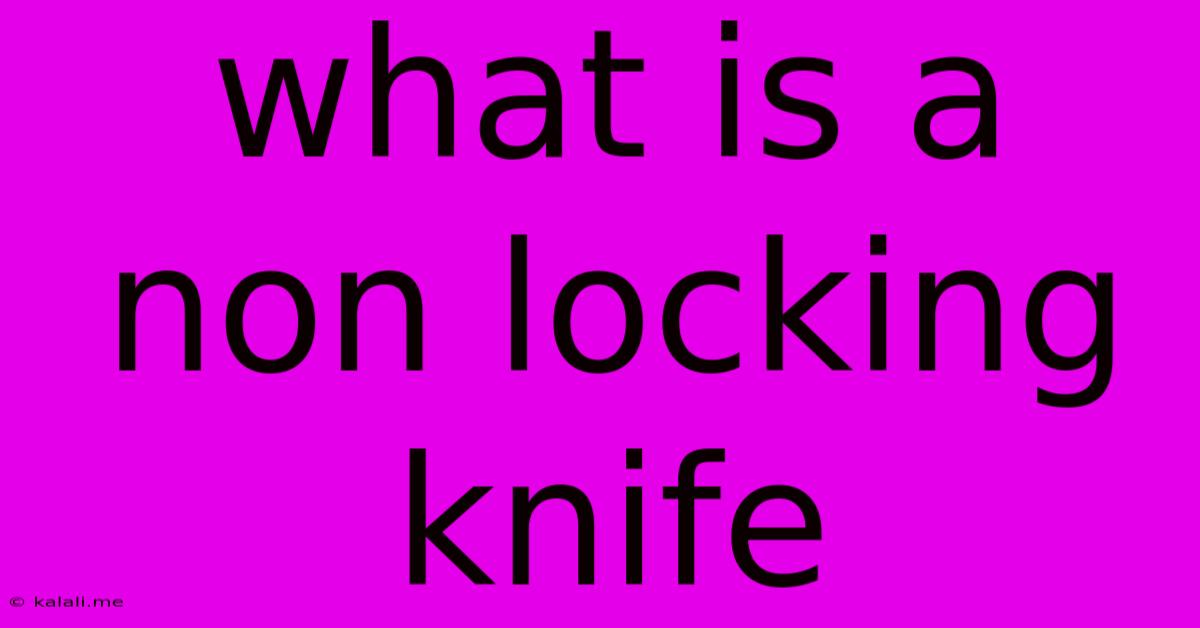What Is A Non Locking Knife
Kalali
May 20, 2025 · 3 min read

Table of Contents
What is a Non-Locking Knife? A Comprehensive Guide
A non-locking knife, also known as a slipjoint knife, is a type of folding knife that doesn't have a locking mechanism to keep the blade open. This means the blade relies solely on friction and spring tension to remain in the open position. Unlike locking knives, which offer a secure, rigid blade, non-locking knives are designed for lighter-duty tasks and prioritize safety and ease of closure. Understanding the differences and benefits of a non-locking knife is crucial before choosing one for your needs.
How Does a Non-Locking Knife Work?
The mechanism is simple yet elegant. A non-locking knife uses a spring and a friction-based system to hold the blade open. When the blade is opened, the spring tension keeps it in place. However, any slight pressure on the blade will cause it to close. This inherent lack of a locking mechanism is both its key feature and its primary limitation.
Key Differences Between Non-Locking and Locking Knives
The primary difference, as stated earlier, lies in the locking mechanism. Locking knives possess a mechanism that firmly secures the blade in the open position, preventing accidental closure. Non-locking knives lack this feature, making them inherently safer in some situations but less suitable for heavy-duty tasks. Here's a table summarizing the differences:
| Feature | Non-Locking Knife | Locking Knife |
|---|---|---|
| Blade Lock | No | Yes |
| Safety | Generally safer, less likely to injure | Requires careful handling |
| Durability | Usually less durable for heavy use | More durable for demanding tasks |
| Typical Use | Everyday carry, light tasks | Heavy-duty tasks, outdoor activities |
| Legal Restrictions | Often less restricted by law in certain regions | May be subject to stricter regulations |
Advantages of Non-Locking Knives
- Increased Safety: The lack of a lock means the blade will close if pressure is applied, significantly reducing the risk of accidental injury. This is particularly beneficial for beginners or users with less experience handling knives.
- Ease of Use: They are generally easier to open and close, making them suitable for everyday tasks. The simple mechanism requires less dexterity.
- Legal Compliance: In many jurisdictions, non-locking knives face less stringent regulations compared to locking knives, making them a more readily available option.
- Traditional Design: They often represent a classic and elegant design, appealing to those who appreciate traditional craftsmanship.
Disadvantages of Non-Locking Knives
- Limited Durability: Due to the absence of a locking mechanism, these knives are not suitable for heavy-duty tasks or forceful cutting. The blade may close unexpectedly under pressure.
- Not Ideal for All Tasks: Their fragility makes them unsuitable for demanding work such as woodworking, heavy-duty cutting, or outdoor survival situations.
- Blade Closure: The possibility of the blade closing unexpectedly can be both a safety feature and a disadvantage, depending on the context.
Common Types of Non-Locking Knives
Several types exist, each with subtle variations in design and function. Some common examples include:
- Slipjoint: The most common type, characterized by a simple spring-based mechanism.
- Pen Knives: Often smaller and designed for pocket carry.
- Traditional Pocket Knives: Classic designs emphasizing simplicity and elegance.
Choosing the Right Non-Locking Knife
When selecting a non-locking knife, consider its intended use. For everyday tasks like opening packages or cutting string, a non-locking knife is perfectly suitable. However, if you need a knife for heavier work or tasks requiring a secure blade, a locking knife is a more appropriate choice.
In conclusion, non-locking knives offer a blend of simplicity, safety, and traditional design. While not as robust as locking knives, their ease of use and inherent safety make them a valuable addition to anyone's toolkit, provided they understand their limitations and choose them for appropriate tasks. Remember to always handle any knife with care and respect.
Latest Posts
Latest Posts
-
Water Heater Dripping Water From Relief Valve
May 20, 2025
-
Gta V How To Get Missions
May 20, 2025
-
4 By 2 Timber In Metric
May 20, 2025
-
How Long Can Fish Survive Without A Filter
May 20, 2025
-
How To Get Rid Of Grass Between Paving
May 20, 2025
Related Post
Thank you for visiting our website which covers about What Is A Non Locking Knife . We hope the information provided has been useful to you. Feel free to contact us if you have any questions or need further assistance. See you next time and don't miss to bookmark.